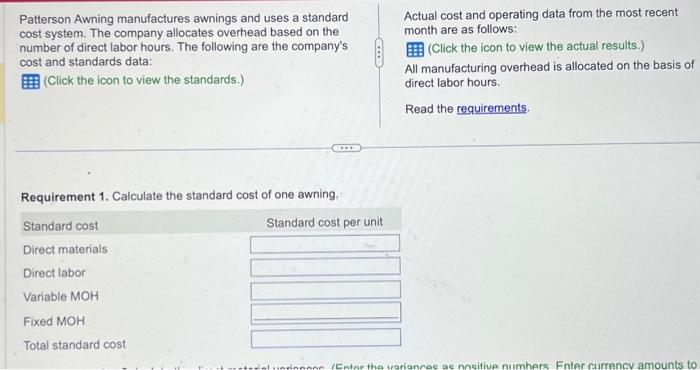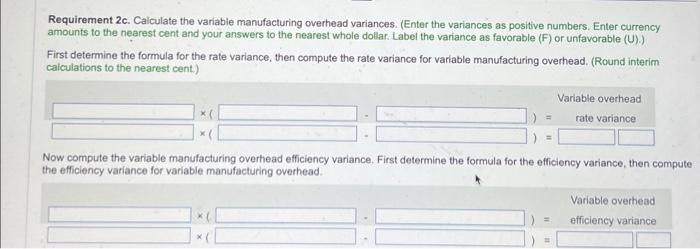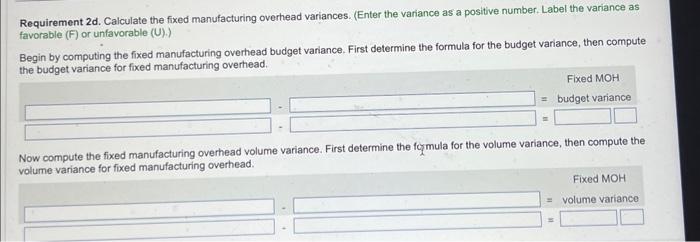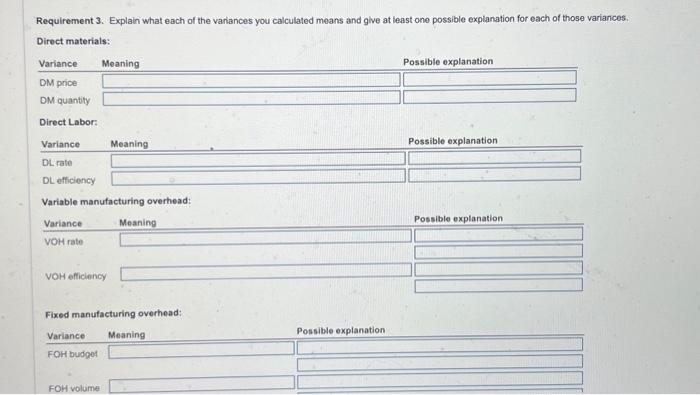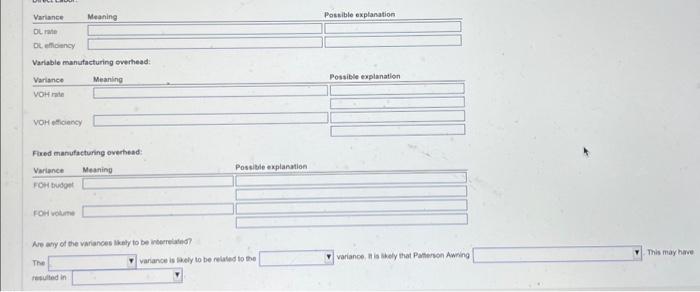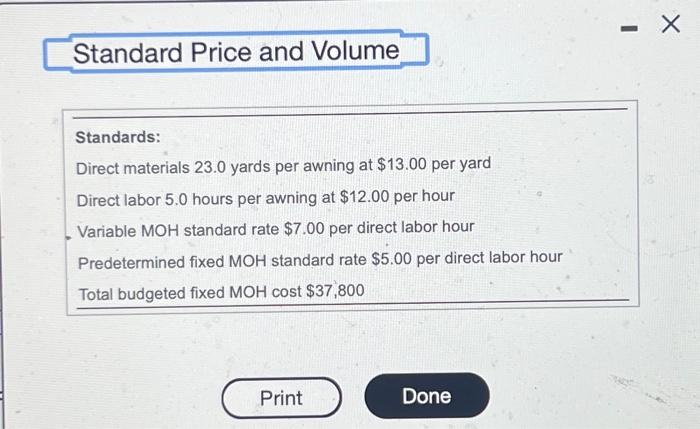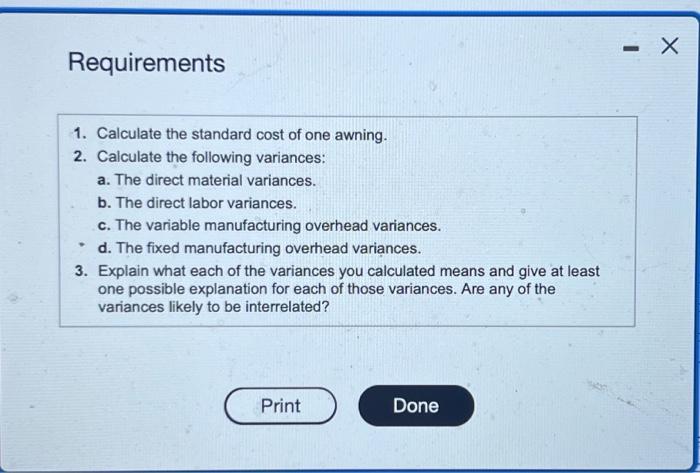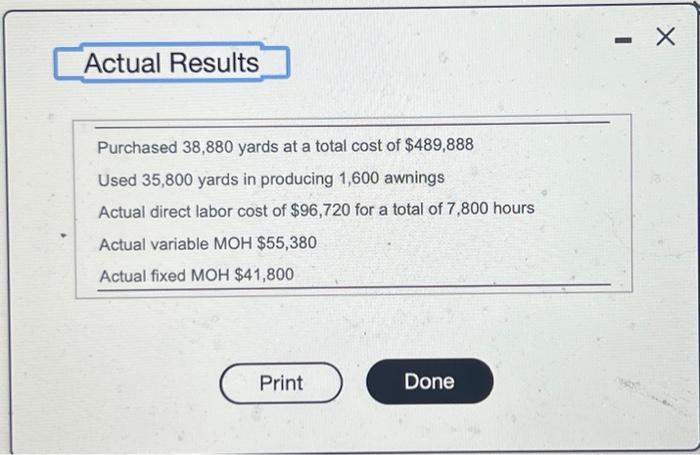Patterson Awning manufactures awnings and uses a standard cost system. The company allocates overhead based on the number of direct labor hours. The following are the company's cost and standards data: (Click the icon to view the standards.) Actual cost and operating data from the most recent month are as follows: (Click the icon to view the actual results.) All manufacturing overhead is allocated on the basis of direct labor hours. Read the requirements. Requirement 1. Calculate the standard cost of one awning. Requirement 2a. Calculate the direct material variances. (Enter the variances as positive numbers. Enter currency amounts to the neares cent and your answers to the nearest whole dollar. Label the variance as favorable (F) or unfavorable (U). Abbreviations used: DM = Direct materials.) First determine the formula for the price variance, then compute the price variance for direct materials. Requirement 2b. Caiculate the direct labor variances. (Enter the variances as positive numbers. Enter currency amounts to the nearest cen and your answers to the nearest whole dollar. Label the variance as favorable (F) or unfavorable (U). Abbreviations used: DL = Direct labor:) First determine the formula for the rate variance, then compute the rate variance for direct labor. First determine the formula for the efficiency variance, then compute the efficiency variance for direct labor. Requirement 2c. Calculate the variable manufacturing overhead variances. (Enter the variances as positive numbers. Enter currency amounts to the nearest cent and your answers to the nearest whole dollar. Label the variance as favorable (F) or unfavorable (U).) First determine the formula for the rate variance, then compute the rate variance for variable manufacturing overhead. (Round interim calculations to the nearest cent.) Now compute the variable manufacturing overhead efficiency variance. First determine the formula for the efficiency variance, then comp the efficiency variance for variable manufacturing overhead. Variable overhead Requirement 2d. Calculate the fixed manufacturing overhead variances. (Enter the variance as a positive number. Label the variance as favorable (F) or unfavorable (U).) Begin by computing the fixed manufacturing overhead budget variance. First determine the formula for the budget variance, then compute the budget variance for fixed manufacturing overhead. Fixed MOH = budget variance = Now compute the fixed manufacturing overhead volume variance. First determine the formula for the volume variance, then compute the volume variance for fixed manufacturing overhead. Requirement 3. Explain what each of the variances you calculated means and glve at least one possible explanation for each of those variances. Direct materials: Variance Meaning Possible explanation DM price DM quantity Direct Labor: Variance DL rate DLefficiency Meaning Variable manufacturing overhead: Variance Meaning VOH rate VOH efficiency Possible explanation Possible explanation Fixed manufacturing overhead: Variance Meaning Possible explanation Possible explanation FOH volume Are ary of the variances lkety to be weerelatnd? The variance is wisly to be relales to the variance, it is skely that Patherson Awring This may have Standards: Direct materials 23.0 yards per awning at $13.00 per yard Direct labor 5.0 hours per awning at $12.00 per hour Variable MOH standard rate $7.00 per direct labor hour Predetermined fixed MOH standard rate $5.00 per direct labor hour Total budgeted fixed MOH cost $37,800 1. Calculate the standard cost of one awning. 2. Calculate the following variances: a. The direct material variances. b. The direct labor variances. c. The variable manufacturing overhead variances. d. The fixed manufacturing overhead variances. 3. Explain what each of the variances you calculated means and give at least one possible explanation for each of those variances. Are any of the variances likely to be interrelated? Purchased 38,880 yards at a total cost of $489,888 Used 35,800 yards in producing 1,600 awnings Actual direct labor cost of $96,720 for a total of 7,800 hours Actual variable MOH$55,380 Actual fixed MOH $41,800
